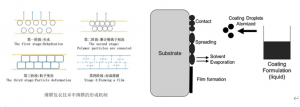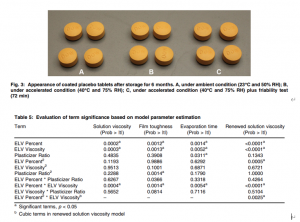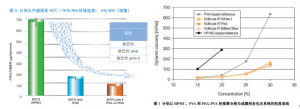Study on the influence of coating materials on the coating process and the quality of coated tablets
We, formulation developers, often encounter various problems during the film coating process: for example, the compatibility between film coating materials and tablet cores, or the problems of sticky tablets, broken skins, orange peel, cracking and so on, which are often encountered during the scaling-up of the coating process. Encountering these problems can sometimes be overwhelming, especially for a novice. Therefore, I feel that, if you want to coat well, first of all, you need to have a certain understanding of the formulation of the coating material, on this basis, based on the characteristics of the coating material (such as different film-forming materials have different optimal film temperature) in order to make a reasonable optimization of the coating parameters to improve the coating efficiency of the product.

The commonly used coating materials are generally Calcon’s Obaday series. On Calcon’s official website, you can see the upgrading process of Obaday products, which is mainly centered on the film-forming material, the first generation of coating powders is based on a single polymer, HPMC, as the film-forming material, such as the commonly used Y-1-7000 model; the second generation is based on a single polymer, PVA, as the film-forming material, such as the commonly used 85G68918 model. model 85G68918. On this basis, there is a gradual development of the use of two or more polymers, as well as further upgrades, i.e. the use of composite polymers, such as PVA-PEG polymers, which have a very low film-forming temperature and therefore a wider operating temperature range.
The principle of film coating technology is that the coating solution or suspension is sprayed onto the surface of the tablet core, where it forms a coating film by contact, spreading, and aggregation of droplets on the surface of the core. If the film-forming material is dissolved in the medium as the basis, the coating material can be divided into solution-type and dispersion-type, solution-type coating liquid is through the atomization, contact with the surface of the tablet and spread, solvent evaporation, polymer chains interpenetrate, experience the gel state, and then further drying to form a thin film; and dispersion-type (droplets of film-forming material is a state of suspension) that is, through the atomization, contact with the surface of the tablet and spread, solvent evaporation, the interconnected Independent molecules are further heated (beyond the minimum film-forming temperature), softened, flowed, and interconnected to form a film.

Film coating materials are generally composed of four parts: film-forming agent, plasticizer, anti-adhesive and coloring agent:
1) Film-forming materials
Commonly used film-forming materials in film coating formulations include: hydroxypropyl methyl cellulose, hydroxypropyl cellulose, polyvinyl alcohol, acrylic resins, polyvinyl pyrrolidone and so on. Among them, HPMC is most widely used in film coating formulations, but compared with other film-forming materials such as PVA, because the conventional molecular level of HPMC in aqueous film coating solution is more viscous, this characteristic limits its application in some high solid content tablet coating formulations, for example, the author is responsible for the project began to use the coating material is Obaday Y-1-7000, whose main ingredient is HPMC 5cp, the main ingredient is HPMC 5cp. For example, the first coating material used in the project I was in charge of was Obaday Y-1-7000, the main component of which was HPMC 5cp, and the solid content was generally at the level of 12%, with relatively low coating efficiency. With the coating material manufacturers to optimize the formula, in the optimized formula will generally use several specifications at the same time, the comprehensive use of its different physical properties, in addition, may also be added to some of the other auxiliary materials, so that the optimized formula solid content can be increased to 20% or more, greatly improving the performance of the coating and coating efficiency.

For example, there is a literature study: the original low molecular weight HPMC (hypromellose 2906, VLV) film coating formulation, because of the weak mechanical strength of the polymer film, will lead to film coating film stability problems, and in the formulation, add a small amount of 5 wt% conventional HPMC (3.35 wt% HPMC E50 and 1.65 wt% HPMC E3), the optimized coating formulation can be used to improve the coating performance and efficiency. The optimized coating formulation significantly improves the toughness of the coating film and thus improves the storage stability and quality of the tablets, while at the same time maintains a highly efficient coating process and mild coating conditions, and avoids the risk of “sticky tablets” to the greatest extent possible.
In addition to HPMC, which is the most commonly used film-forming material, PVA (Polyvinyl Alcohol) has been gradually developed into a new generation of film-forming agent, which has significant advantages compared with HPMC, such as small molecular weight (lower viscosity of the solution, higher solid content, and more efficient coating), more hydrogen bonding sites (greater tensile strength of the film, stronger adhesion to the core of the tablet, denser film, and stronger moisture and oxygen barrier), molecular arrangement (higher flexibility, and clearer film surface), and higher flexibility of the film. (higher flexibility, clearer membrane surface, more suitable for lettering sheet) and so on. However, it also has some drawbacks, for example, because of its hydrogen bonding site more, the formation of the coating film is more dense, there is a certain water locking capacity, bringing another problem may be more prone to sticking to the tablets, and therefore requires a higher temperature of the tablet bed (40 ℃ or more). In order to further improve the coating efficiency, there is a gradual emergence of two or more polymers, as well as further upgrading, such as PVA-PEG polymers (Kollicoat® IR series), which has a very low film-forming temperature, and thus a wider range of operating temperatures.

2) Plasticizers
Film coating is a complex process and plasticizers are often added to HPMC or PVA based coating formulations in order to ensure the spreading and film forming ability of the coating solution. The addition of plasticizers softens the film, reduces brittleness, increases flexibility and alters thermal stability, improves the abrasion resistance of the sheet, and lowers the glass transition temperature. Commonly used plasticizers include: water-soluble propylene glycol, glycerol, polyethylene glycol, or non-water-soluble phthalate esters, castor oil, and so on. For example, it has been studied in the literature that the addition of plasticizers PEG-400 (1.5%) and PG (1%) to coating formulations using HPMC as the film-forming agent had a significant effect on the film-forming properties of HPMC. The films formed with HPMC+ PEG400 (1.5%) or PG (1%) were free from major defects such as surface roughness, cracking, orange peel, and stickiness, and the gloss of the film surface was better.
There are two main ways to add plasticizer in coating formulation: a. Physical mixture (common are this way); b. Pre-compound polymer compounds with plasticizer (this can improve the flexibility of the molecular chain as much as possible, and improve the toughness of the film). And the amount of plasticizer in the coating formula should be moderate, with too little can not overcome the shortcomings of the polymer deformation, too much will make the concentration of the coating solution is relatively large, the fluidity is weakened, not conducive to spray operation.
Formulation contains plasticizer, may bring another problem is: because the liquid plasticizer in the drying process may be migrated, thus leading to the surface of the film appear oil spot or local color difference and other problems; In addition, plasticizer may exist with the core incompatible problem, such as PEG will decompose formaldehyde, thus with the core reaction to generate a number of impurities containing methoxyl, and so on. Therefore, when choosing coating materials, you also need to focus on the compatibility of the components of the coating material with the core.
3)Anti-adhesive agent
A certain amount of anti-adhesive agent will be added to the coating formula to reduce the risk of sticky tablets in the process of film formation; its characteristics are: hydrophobicity, particle size will affect the roughness of the film. And the addition of these hydrophobic materials to the film-forming solution improves water vapor barrier properties. Commonly used anti-adhesive agents in prescription are talc, micronized silica and stearic acid. For example, the addition of stearic acid to HPMC-based coating formulations has been studied in the literature. The surface structure, hydrophobic/hydrophilic, adhesion and friction properties of the membranes were significantly changed by the incorporation of stearic acid into the HPMC membranes. The high hydrophobicity induced by the high content of long-chain fatty alcohols and alkanes in stearic acid resulted in reduced hydrophilicity and water transfer of the membrane. The results showed that fatty acids as hydrophobic additives doped into HPMC membranes reduced the surface free energy of the membranes and the average membrane roughness decreased with the increase of stearic acid content.
4) Colorants
A certain amount of coloring agent is also added to the coating formulation, the purpose of which is mainly to shade the light, improve the stability of light-sensitive drugs, improve the appearance, and be used to distinguish the products. It is characterized by insolubility, particle size affects the film roughness and color uniformity. Commonly used colorants include: titanium dioxide, natural pigments, iron oxide mineral pigments, aluminum chromophoric synthetic pigments and so on.
For example, there is literature to nifedipine as a model drug (because it has a strong photosensitivity, exposure to sunlight and ultraviolet light can be degraded to many photodegradation products), the study of coating formulations containing different concentrations of titanium dioxide on the stability of the drug, the results show that increasing the concentration of titanium dioxide to the level of 29.5% can significantly reduce the level of photodegradation of nifedipine drug. However, the concentration of coloring agent is not the higher the better, usually the concentration is limited to the level of about 30%, because the concentration is too high will damage the formation of the film during the film coating process.
5) Other additives
There are some coating formulations, in addition to the above basic composition, will also introduce some other fillers, for example, will be added to a certain amount of surfactants such as sodium dodecyl sulfate, Tween 80, etc., because the hydrophobic component of the coating formula may hinder the penetration of the film coating solution and spreadability, and the addition of surfactants can improve the role of the coated on the surface of the core of the spreading efficiency is more uniform.
Alternatively, some microcrystalline cellulose, lactose, etc. may be added to the base coating formulation based on the product properties, for example, the introduction of additives of microcrystalline cellulose, lactose, and Tween 20 to the coating formulation has been studied in the literature, and the results have shown that the addition of the additives affects the adherence of the film coating on the surface of the core of the tablet. The maximum adhesion was obtained when microcrystalline cellulose was added to the coating formulation, which may allow a strong interaction with the same component MCC in the tablet core. And cellulose is bipolar and interacts with lactose, the other main component of the tablet core. Adhesion is enhanced when tablet cores are made at higher compaction forces. If the tablet core is formulated differently from what was studied, the adhesion exhibited with MCC coating is not necessarily observed.
This suggests to us that if the adhesion of the film coating material to the tablet core is not strong, we can actually try to communicate with the manufacturer of the coating material to purposely customize the coating formulation based on the characteristics of the basic product so as to improve the coating efficiency of the tablets and improve the stability of the product.
In summary, we still need to make a detailed understanding of the formulation of the coating of our formulation developers, in order to find problems in the process of product coating, and targeted problem solving. Of course, understanding the composition of the coating formula is only the first step, but also need to be combined with the performance parameters of the coating, such as coating operation process parameters need to be strictly referenced to the characteristics of the coating material, such as the temperature of the sheet bed must be combined with the material film-forming temperature, the relationship between rotational speed and film abrasion resistance, etc., to refer to the design of coating parameters, so as to improve the aesthetics and stability of the product.
Translated with DeepL.com (free version)

